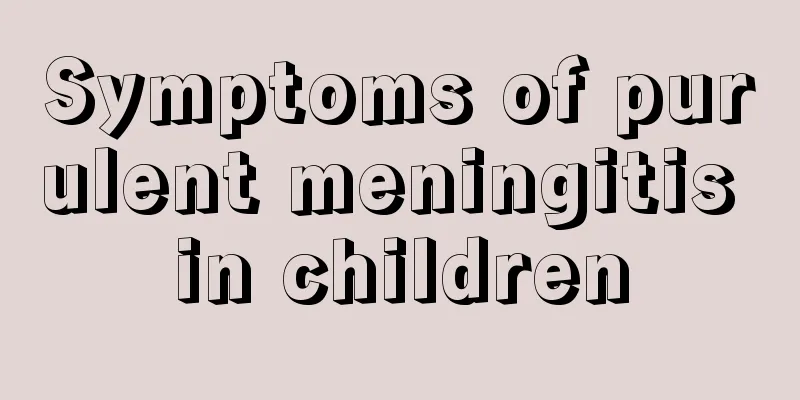Symptoms of otitis media in children

|
It is quite common for children to suffer from otitis media. In order to detect the disease earlier, parents need to understand the symptoms of otitis media in their children. Otitis media in children is often acute when it occurs, and is often manifested by a feeling of swelling and pain in the ear area and a feeling of blockage in the ear. Other symptoms are accompanied by fever and headache. For this reason, many parents mistake their children's otitis media symptoms for colds, thus delaying treatment. 1. Symptoms of otitis media in children Otitis media, especially acute suppurative otitis media, is more common in children. Clinical manifestations include swelling and pain in the ear area, a feeling of stuffiness or blockage in the ear, hearing loss and tinnitus. Sometimes changes in head position can improve hearing. There is self-auditory enhancement. Children often show slow listening or poor concentration. It may be accompanied by systemic symptoms such as fever, headache, fatigue, and loss of appetite. Once the eardrum is perforated, pus can be seen flowing out of the ear, and the symptoms of swelling will be alleviated. It often occurs during colds, tonsillitis, acute infectious diseases, or occurs unconsciously. If acute suppurative otitis media is not treated promptly or improperly in the acute phase, once it turns into chronic otitis media, it will not only lead to hearing loss but may even cause serious complications. Types and manifestations of otitis media in children 1. Catarrhal otitis media Also known as exudative otitis media or non-suppurative otitis media, it is common in infants and young children and is mostly caused by Eustachian tube dysfunction and negative pressure in the middle ear. Symptoms include stuffy ears, hearing loss, loud voices, noises in the ears when swallowing, tinnitus like blowing wind, sound of air passing through water in the ears when blowing the nose, and mild ear pain. 2. Acute suppurative otitis media It often occurs in cases of upper respiratory tract infection or acute infectious diseases, especially in children who are weak, have low immunity, are anemic, have diabetes, etc. The pathogenic bacteria include hemolytic streptococci, pneumococci, influenza bacilli and Staphylococcus aureus. (1) Local symptoms ① When ear pain occurs, there is extreme pain deep in the ear, and there may also be tenderness in the mastoid area or headache on the affected side. It often occurs at night, and the child wakes up in pain. The child scratches his ears or shakes his head, is irritable and cannot fall asleep, cries and refuses to eat. ② Otorrhea Once the eardrum is perforated, pus can be discharged from the ear canal. It may be bloody at first and then become mucopurulent. (2) Systemic symptoms are more severe in children than in adults. The high fever may reach over 40°C, and there may be febrile convulsions, vomiting, diarrhea, and in severe cases, symptoms of meningeal irritation. (3) Local examination showed that the inflammation lasted for 2 to 3 days, with pus accumulating and the eardrum bulging. Finally, the tense part of the eardrum ruptured, with pus overflowing and the ear pain slightly relieved. Examination: Before perforation, the entire tympanic membrane is extremely congested, the marks disappear, and it bulges outward; after perforation, pulsating pus is often seen from the perforation. Hearing examination showed conductive hearing loss. If the mastoid is affected, the mastoid will be red, swollen and tender. |
<<: Baby's face has coffee spots
>>: What to do if swelling occurs after vaccination
Recommend
Baby has a fever and his belly is very hot
Whenever the baby has a physical condition, paren...
What causes migraine in children?
Migraines mostly occur in adults, but children ca...
How can children exercise to grow taller?
How tall a child can grow is related to many fact...
How to treat children’s tics with traditional Chinese medicine?
Children's tics should be discovered and trea...
What are the developmental indicators of eight and a half month old babies?
Every child is an angel, and the birth of a newbo...
What is the reason for the child to have a fever every two or three days?
If a child has a fever every other day, the most ...
When is the best time for children to have orthodontic treatment?
It can be said that the quality of teeth is very ...
The child has repeated fever and blisters at the mouth
Children have poor body resistance and are prone ...
Symptoms of adenoid hypertrophy in children
When it comes to adenoids hypertrophy, many peopl...
Early symptoms of vitiligo in children
We all know that vitiligo is a particularly stubb...
Correct sleeping position for newborns
Sleep occupies most of the baby's life, so go...
Twitching in the middle of the night
I believe many people have had this experience: w...
The dangers of pathological jaundice in children
Pathological jaundice is a common disease in newb...
What to do if your child has asthma
The air quality is particularly poor now, so ther...
What to do if your child has a lot of earwax
Earwax is a yellow liquid. Some people have drier...









